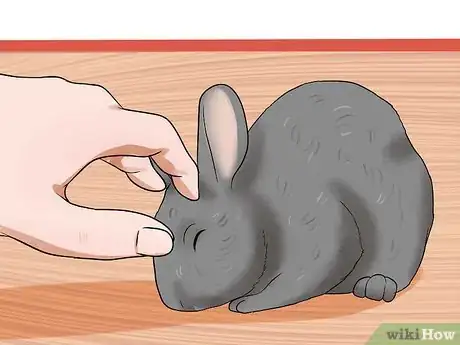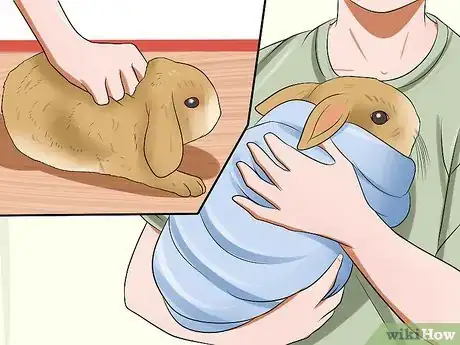This article was co-authored by Pippa Elliott, MRCVS. Dr. Elliott, BVMS, MRCVS is a veterinarian with over 30 years of experience in veterinary surgery and companion animal practice. She graduated from the University of Glasgow in 1987 with a degree in veterinary medicine and surgery. She has worked at the same animal clinic in her hometown for over 20 years.
This article has been viewed 9,808 times.
Many people keep rabbits as pets. After all, they're quiet, docile, and cuddly. But you shouldn't just bring home a rabbit on a whim. Rabbits need time and training before they will trust you. If you just got a new bunny, or are planning to do so soon, these steps will help you establish a trusting relationship with your new pet.
Steps
Making Your Rabbit Feel at Home
-
1Prepare the rabbit's home. This should be done before your rabbit arrives for the first time so that it can get used to its new home (and you!) quickly. You will need an assortment of accessories in order for your rabbit to be comfortable.
- Accessories needed for a hutch are water bottle, food trough or heavy food crock, large plastic litter box, and litter like you would purchase for a cat.
- You may want to add cedar pet bedding to keep the hutch smelling fresh.
-
2Set the hutch in a common room. To help your rabbit trust his home, place your hutch on the floor in a room where you spend a lot of time. Shutting a rabbit away in a room will make it unsure of the outside world. The more exposure your rabbit has to you, the more it will trust you.
- Do not place the hutch near a heater or TV or stereo. Loud noises frighten rabbits. They are used to a quiet, peaceful existence. You'll know your rabbit is frightened when it lays it ears flat against its head.[1]
- Keep the hutch away from direct sunlight, as through a window. Heat and rabbits do not mix well, and rabbits can die from becoming overheated.[2]
Advertisement -
3Have food ready. To reinforce the idea that your rabbit can trust you, have food on hand. A nice crunchy carrot is a good way to make your rabbit feel comfortable and to attract it to you during playtime.
- Rabbits like to chew for enjoyment, but mainly because their teeth are always growing and chewing keeps them trimmed. Offer them crunchy fresh vegetables such as carrots, celery, and lettuce.[3]
- You can also offer wood, cotton towels, and un-treated grass mats.
-
4Use a pet carrier. To help your rabbit trust you during car rides, place it in a pet carrier. This prevents the rabbit from feeling overwhelmed, and makes its transport safer and more comfortable.
- Rabbits do not like car trips, so making them comfortable is important so they continue to trust you. Remember that they don't like loud noises.
- You must protect your bunny from the heat. Place a cool, damp towel over the carrier and place a frozen bottle of water next to it.
Bonding with Your Rabbit
-
1Let the rabbit get used to its hutch. If you're bringing your rabbit home for the first time, transfer it directly from the pet carrier to the hutch. Make sure the hutch is located in a common room like the living room or kitchen and near the door, at least for the first day.
- Before placing your rabbit into the arms of excited family members or on the floor in a common room, allow the bunny to sit in its hutch for 12-24 hours. This allows it to get used to the sounds and smells of your home while feeling secure.
- Let your bunny learn that its cage is a safe place where food and shelter is. If your rabbit doesn't know that, it will never learn to trust the person who put it there.
- Never allow anything even remotely dangerous into the hutch, and make sure it's always well stocked with food and water.
-
2Let the rabbit get used to your home. Once the rabbit has been in its hutch for 12-24 hours and appears to have calmed down, you may open the door and let it hop out.
- Get down on the same level as the rabbit. Letting your rabbit come to you in its own time will assist in the bonding process and help it learn to trust you. Don't interfere with the bunny at first. Rabbits are naturally curious, and they will come to you on their own.[4]
-
3Sit with your bunny. After a few days of sitting with your rabbit while it explores, it should accept your presence. At this point, you may allow the rabbit to climb on you. Be sure not to pull it up.
- No sudden movements or touching or stroking the rabbit. This will allow it to get used to your presence and relax with you there. Sudden movements frighten rabbits and will delay developing their trust.
- Allow the rabbit to climb on you. Try to avoid any jerking. The rabbit must learn that you aren't something that's going to lure it closer and then grab it. Your bunny must learn that you are safe to be around and can be trusted.
-
4Start petting your bunny. After several days of allowing the rabbit to accept your presence and crawl into your lap, you can start stroking its head and the sides of its face.
- Don't be excessive, but let it know that stroking is completely harmless and a way you are expressing love.
- Do not crowd your rabbit. Just stroke it when it sits down next to you or crawls into your lap.
-
5Start handling your rabbit. Begin slowly, picking it up twice a day, during designated playtimes.
- After a couple of days of this, the bunny will finally know that you are safe to be around.
-
6Allow the bunny as much time as it needs. If your rabbit still won't approach you after sitting with it during playtime for several days, don't force it. Continue to help the rabbit acclimate by doing things you'd normally do in the same room.
- You can try cooking while the bunny plays, or watching TV at a low volume if it's in the living room or den.
- Eventually your bunny will trust you. Keep offering healthy snacks and getting down on its level to show you aren't a threat.
Maintaining Your Rabbit's Trust
-
1Keep playing. Don't stop playing with your bunny just because it trusts you. You should play with it every day to maintain your good relationship and build on the trust you've already created.
- Bring a healthy snack to each playtime in order to encourage your rabbit to believe you are safe.
-
2Spend time with your rabbit daily. Try daily sessions of half-hour increments of just sitting with your rabbit.
- When your rabbit seems more comfortable in your arms (it will never be completely comfortable), pick it up for a short cuddle occasionally.
-
3Acclimate your bunny to strangers. If you know you are going to have guests over, explain to them that bunnies need time to get used to strangers. Do not take your bunny out of its hutch around strangers until everyone has been briefed on how to treat the rabbit.
- This is especially important if small children will be around the bunny. Because children are louder and less coordinated than adults, it is easy for them to accidentally be rough with rabbits. Instruct small children in how to handle a rabbit, and supervise their interactions at all times.
Warnings
- When frightened, rabbits can run very fast, kick, scratch, even bite if threatened enough.⧼thumbs_response⧽
- You will need to train a fearful rabbit (one that has been abused, for example) even more carefully than presented in the above steps.[5]⧼thumbs_response⧽

































































